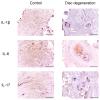Immunomorphogenesis in Degenerative Disc Disease: The Role of Proinflammatory Cytokines and Angiogenesis Factors
- PMID: 37626681
- PMCID: PMC10452407
- DOI: 10.3390/biomedicines11082184
Immunomorphogenesis in Degenerative Disc Disease: The Role of Proinflammatory Cytokines and Angiogenesis Factors
Abstract
Back pain (BP) due to degenerative disc disease (DDD) is a severe, often disabling condition. The aim of this study was to determine the association between the expression level of proinflammatory cytokines (IL-1β, IL-6, and IL-17), angiogenesis markers (VEGF-A and CD31) in intervertebral disc (IVD) tissue and IVD degeneration in young people with discogenic BP. In patients who underwent discectomy for a disc herniation, a clinical examination, magnetic resonance imaging of the lumbar spine, histological and immunohistochemical analyses of these factors in IVD were performed in comparison with the parameters of healthy group samples (controls). Histology image analysis of IVD fragments of the DDD group detected zones of inflammatory infiltration, combined with vascularization, the presence of granulation tissue and clusters of chondrocytes in the tissue of nucleus pulposus (NP). Statistically significant increased expression of IL-1β, IL-6, IL-17, VEGF-A and CD31 was evident in the samples of the DDD group compared with the controls, that showed a strong correlation with the histological disc degeneration stage. Our results denote an immunoinflammatory potential of chondrocytes and demonstrates their altered morphogenetic properties, also NP cells may trigger the angiogenesis.
Keywords: Angiogenesis markers; CD31; Modic changes; back pain; chondrocyte clusters; degenerative disc disease; immunohistochemistry; proinflammatory cytokines; young age.
Conflict of interest statement
The authors declare no conflict of interest.
Figures







References
LinkOut - more resources
Full Text Sources
Research Materials
Miscellaneous

